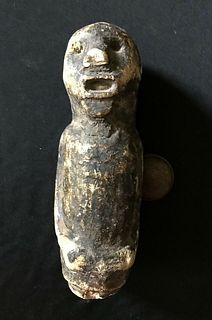Tall 20th C. Tlingit Carved Wood Totem - Man w/ Fish
Lot 68
About Seller
Artemis Fine Arts
686 S Taylor Ave, Ste 106
Louisville, CO 80027
United States
Selling antiquities, ancient and ethnographic art online since 1993, Artemis Gallery specializes in Classical Antiquities (Egyptian, Greek, Roman, Near Eastern), Asian, Pre-Columbian, African / Tribal / Oceanographic art. Our extensive inventory includes pottery, stone, metal, wood, glass and textil...Read more
Estimate:
$4,000 - $6,000
Absentee vs Live bid
Two ways to bid:
- Leave a max absentee bid and the platform will bid on your behalf up to your maximum bid during the live auction.
- Bid live during the auction and your bids will be submitted real-time to the auctioneer.
Bid Increments
| Price | Bid Increment |
|---|---|
| $0 | $25 |
| $300 | $50 |
| $1,000 | $100 |
| $2,000 | $250 |
| $5,000 | $500 |
| $10,000 | $1,000 |
| $20,000 | $2,500 |
| $50,000 | $5,000 |
| $100,000 | $10,000 |
| $200,000 | $20,000 |
About Auction
By Artemis Fine Arts
Oct 15, 2020
Set Reminder
2020-10-15 12:00:00
2020-10-15 12:00:00
America/New_York
Bidsquare
Bidsquare : Art of the Americas - Ancient to Present
https://www.bidsquare.com/auctions/artemis-gallery/art-of-the-americas---ancient-to-present-5840
Ancient and ethnographic art from cultures encompassing the Americas - Pre-Columbian, Native American, Northwest Coast, Spanish Colonial, more. All legally acquired, all legal to sell, all guaranteed to be as described or your money back. Convenient in-house shipping! Artemis Fine Arts info@artemisfinearts.com
Ancient and ethnographic art from cultures encompassing the Americas - Pre-Columbian, Native American, Northwest Coast, Spanish Colonial, more. All legally acquired, all legal to sell, all guaranteed to be as described or your money back. Convenient in-house shipping! Artemis Fine Arts info@artemisfinearts.com
- Lot Description
Native American, Pacific Northwest Coast, Alaska, Tlingit, ca. early to mid-20th century CE. A massize totem figure likely carved from cedar. The totem is a stylized anthropomorphic man that squats against a flat panel. He has a broad face, open eyes, narrow mouth, large eyebrows that create an anxious, almost startled, expression. He grasps a large fish by the tail and the fish’s body hangs down between his feet; the fish has incised carved fins and eyes. The back side of the totem is flat where it perhaps leaned up against a wall as a post or supported a part of a building. Traces of white pigment around the eyes and hands, indicate that this totem was painted at one time, a popular practice that made these wooden sculptures stand out vibrantly from the landscape and perhaps had symbolic meaning. Size: 17.5" W x 48" H (44.4 cm x 121.9 cm); 50" H (127 cm) on included custom stand.
Indigenous people from coastal north west America to Canada created zoomorphic and anamorphic carvings, totem poles, as standalone columns, or to support larger architectural structures. Totem poles are used to welcome visitors, commemorate the dead or important events, and to even shame people that have offended the tribe. Originally only elite members commissioned totem poles, as these massive pieces were quite an undertaking to carve, and sometimes took between six months to a year to complete! The exact narrative or symbolic meaning the totems conveyed was often known exclusively to the tribe to which it belonged through oral tradition. The animals depicted were often easily identified across tribes, and therefore information could be gathered, even if the person was unable to interpret the full meaning of the totem. The creation of totem poles became highly popularized and more accessible in the early to mid-19th century when the native cultures gained new metal tools and wealth from the fur trade with the European settlers. Most wood totems do not last more than a hundred years in the moist northwest coastal climate, but this totem has retained its striking features, and presents a fishing lineage or narrative.
Provenance: private Newport Beach, California, USA Collection
All items legal to buy/sell under U.S. Statute covering cultural patrimony Code 2600, CHAPTER 14, and are guaranteed to be as described or your money back.
A Certificate of Authenticity will accompany all winning bids.
We ship worldwide and handle all shipping in-house for your convenience.
#159656Stable fissures with areas of crevices reinforced with glue. Right foot reattached with radiating fissures. Nicks, chips, abrasions and surface wear. Losses to peripheries of facial details and loosening of left eye lid, with small nail reinforcing the area. Beautiful surface patina and details!Condition
- Shipping Info
-
All shipping is handled in-house for your convenience. Your invoice from Artemis Gallery will include shipping calculation instructions. If in doubt, please inquire BEFORE bidding for estimated shipping costs for individual items.
-
- Buyer's Premium



 EUR
EUR CAD
CAD AUD
AUD GBP
GBP MXN
MXN HKD
HKD CNY
CNY MYR
MYR SEK
SEK SGD
SGD CHF
CHF THB
THB














